2022 Ford F-150 Review: Lightning Strikes
The electric Ford F-150 Lightning headlines the news for this year's edition of America's favorite truck.
Review QuickTakes:
Available in regular cab, extended cab (SuperCab), and crew cab (SuperCrew) configurations, the 2022 Ford F-150 is America's best-selling full-size light-duty pickup truck. Following a 2021 redesign and the arrival of the new 2022 F-150 Lightning, it is also arguably the most technologically sophisticated truck available today, with the most diverse model range and powertrain menu. So if you can't find a 2022 Ford F-150 that meets your needs, you're not looking hard enough.
What's New for the 2022 Ford F-150?
Following a complete redesign for 2021, Ford immediately put the all-new F-150 on a continuous improvement program. During the 2021 model year, the F-150 lineup added a new Tremor off-road model and reintroduced the off-road performance Raptor variant. New towing technologies called Onboard Scales and Smart Hitch also debuted late in the model year.
Want to learn more about the redesigned 2021 Ford F-150? Read our review of the 2021 F-150 equipped with the Powerboost hybrid drivetrain.
Changes for the 2022 Ford F-150 include new Black Appearance packages for XL, XLT, Lariat, and Platinum trims. In addition, Ford cancels the optional turbo-diesel V6 engine.
The big news, however, is the arrival of the 2022 F-150 Lightning electric truck. The dual-motor EV comes with a standard- or extended-range battery pack and offers between 230 miles and 320 miles of estimated driving range. Ford says it targets an output of 563 horsepower and 775 pound-feet of torque, a 2,000-pound payload capacity, and 10,000 lbs. of towing capacity. Acceleration to 60 mph will take about 4.5 seconds.
Since there isn't an internal combustion engine under the hood, the F-150 Lightning has a 14.1 cubic-foot front trunk (or frunk) with access to 2.4-kilowatts of exportable power, a 400-lb payload capacity, and a drain plug in the floor. The Lightning can also power your home for days during an outage, and it introduces Ford's BlueCruise hands-free driving assistance technology to the F-150 lineup.
How Much is a Ford F-150?
This year, 2022 Ford F-150 prices range from the low $30,000s to the low $90,000s, including the destination charge to ship the truck to your local dealership. Ford builds the F-150 in Dearborn, Michigan, near its world headquarters building, and Claycomo, Missouri, near Kansas City.
2022 Ford F-150 Trim Levels and Configurations
In addition to three cab styles and three cargo bed lengths, Ford offers the gas-fueled 2022 F-150 in nine different trim levels. They summarize as follows:
Ford F-150 XL – Designed more for work than play, the F-150 XL is basic but still includes modern infotainment and safety systems.
Ford F-150 XLT – Popular XLT trim dresses up the F-150 with chrome trim, aluminum wheels, and a nicer interior while adding more safety features. Ford also makes more options available for the F-150 XLT.
Ford F-150 Lariat – Moving up to the Lariat trim means 18-inch aluminum wheels, heated and ventilated leather seats, dual-zone automatic climate control, a 12-inch digital instrumentation display, and a 12-inch touchscreen infotainment system. A 2.7L twin-turbo V6 engine is also standard in this version of the truck.
Ford F-150 Tremor – Tremor trim equips the F-150 for off-roading with a 3.5L twin-turbo V6, standard 4-wheel drive, dark-matte finish 18-inch wheels with all-terrain tires, a locking rear differential, a lifted and reworked suspension, off-road cruise control, a Rock Crawl off-roading mode, and more.
Ford F-150 King Ranch – This western-themed version of the F-150 is based on the Lariat and comes with a V8 engine, two-tone paint, special 18-inch aluminum wheels, unique leather upholstery, heated second-row seats, a premium sound system, and more.
Ford F-150 Platinum – Platinum trim also builds on Lariat equipment, adding luxury in the form of polished 20-inch aluminum wheels, real wood trim, a premium sound system, a navigation system, and several added driving assistance technologies.
Ford F-150 Limited – The most luxurious F-150 features polished 22-inch wheels, an adaptive damping suspension, a power tailgate, premium leather, and massaging front seats. It also gets a Pro Power Onboard system that can export up to 7.2-kW of power to turn the truck into a mobile generator and the entire collection of Ford Co-Pilot360 Active 2.0 technologies, including BlueCruise.
Ford F-150 Raptor – Ford equips the Raptor with a high-output twin-turbo V6 engine, a sport exhaust system, a modified long-travel suspension, underbody skid plates, and its full arsenal of off-roading tech. It rides on 17-inch aluminum wheels wrapped in performance all-terrain tires.
2023 Ford F-150 Raptor R – Next year the Raptor R will feature a 5.2L supercharged V8 that cranks out 700 hp and 640 lb.-ft. of torque. It will sport unique styling, 37-inch tires, and a suspension designed to take advantage of all that power..
Separately, there are four versions of the new all-electric F-150 Lightning available:
Ford F-150 Lightning Pro – Made for commercial use, the Pro has vinyl seats but includes plenty of infotainment and safety technology combined with the key benefits of the F-150 Lightning.
Ford F-150 Lightning XLT – With cloth seats, enhanced 360-degree zone lighting, running boards, a surround-view camera system, and a center console that transforms into a work surface, XLT trim makes the Lightning more livable. Ford also dresses the exterior with a nicer grille and signature full-width lighting.
Ford F-150 Lightning Lariat – A set of 20-inch aluminum wheels, a power tailgate, leather seats with heating and ventilation, and a 15.5-inch touchscreen infotainment system are among the Lariat's standard features.
Ford F-150 Lightning Platinum – A black grille and big 22-inch aluminum wheels identify the Platinum on the outside, while the cabin gets premium leather, massaging front seats, a panoramic sunroof, and a high-end audio system.
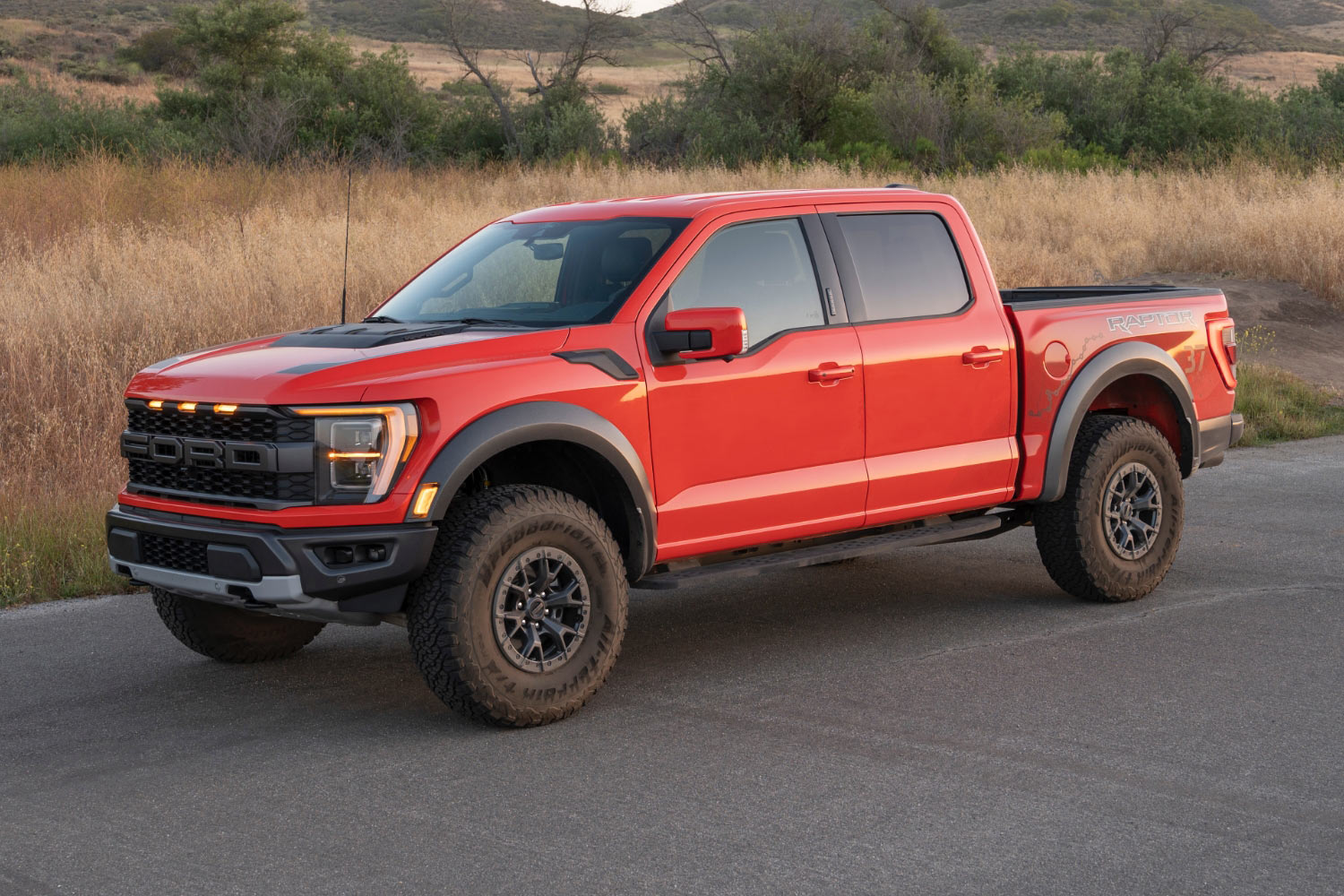 Michael Harley
Michael Harley
2022 Ford F-150 Review and Test Drive
By Michael Harley
Test Drive QuickTake:
The Ford F Series is the world's best-selling vehicle, a title it has held since 1977. Last year, Ford sold 726,004 units of its popular truck line, 156,616 more than the second-place Ram). As expected, sales volumes of that magnitude require an extremely varied model range, and Ford delivers.
Ford claims the F-150 is "America's choice for getting the job done for 44 consecutive years" and that the model's current generation "is purpose-built to be the toughest, most productive F-150 ever." The company touts the truck's payload and towing capacities, rugged steel chassis, and lightweight sculpted aluminum body designed to make it the most aerodynamic F-150 in history. The company also notes the connected vehicle innovation that includes over-the-air updates allowing the F-150 to be "at the forefront of purposeful technology."
Customers demand a lot from their Ford trucks. They want customization, so the automaker offers a variety of cabin configurations, engine choices, driveline options, bed lengths, and cosmetic enhancements. For example, there are no fewer than 11 different grille options that help set the models and trim levels apart.
For this 2022 Ford F-150 review, I test-drove two very different versions of the truck. The F-150 Raptor is the "desert runner" model, with heavy-duty off-road components that allow it to tackle challenging trails, dunes, and rocks. It has a powerful engine, massive tires, and an aggressive appearance package to match its attitude.
The F-150 Lightning is all-new for 2022, a pure-electric truck engineered to match its combustion peers in durability and performance. It offers standard and extended range battery packs, exceptional utility, and impressive towing capacity. Plus, its pure-EV technology provides a few unique advantages over the F-150 gasoline and hybrid models.
The F-150 Raptor and F-150 Lightning test vehicles came in a 4WD SuperCrew configuration with a 145-inch wheelbase and short 5.5-foot bed. Ford provided both vehicles for me to evaluate in Southern California.
My F-150 Raptor had a standard twin-turbocharged 3.5L V6 engine and several options, including the Raptor High Equipment Group ($4,755), the Raptor 37 Performance Package ($5,250), the 2.0kW Pro Power Onboard upgrade ($995), and a spray-in bed liner ($595). The Manufacturer's Suggested Retail Price (MSRP) was $83,295, including the $1,795 destination fee.
My F-150 Lightning Lariat had the standard-range battery plus Equipment Group 511A ($10,000), Rapid Red metallic paint ($495), the Max Trailer Tow Package ($825), and a spray-in bed liner ($595). The Manufacturer's Suggested Retail Price (MSRP) was $80,589, including the $1,795 destination fee.
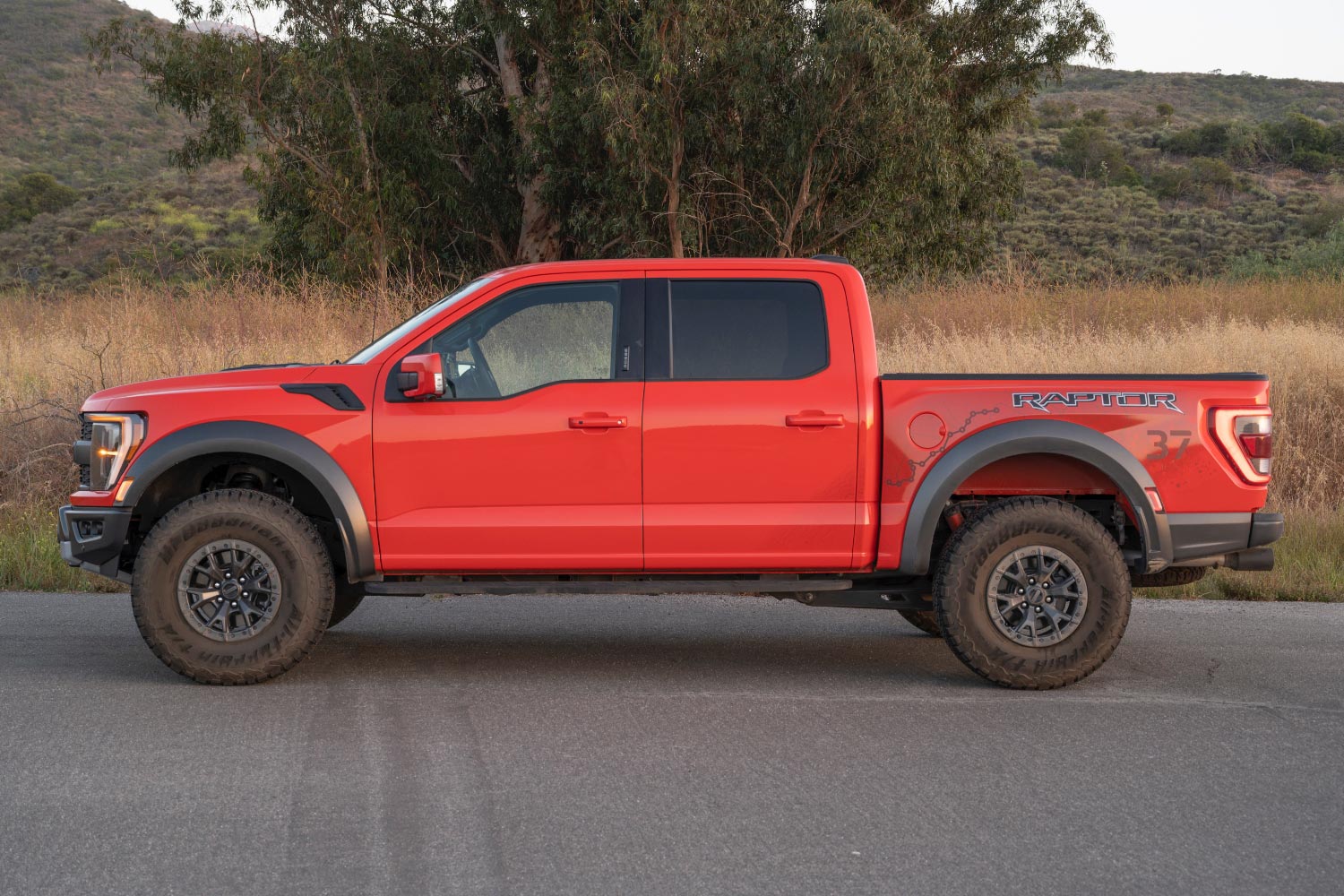 Michael Harley
Michael Harley
2022 Ford F-150 Review: The Design
Ford has done an impressive job with the F-150's exterior styling. All models share the same basic template, with changes to the styling details, wheel designs, and tires to differentiate the unique trim levels. As a result, the overall shape is both classic and modern – a nice blend of functionality and aerodynamic efficiency. Most important, thanks to cues such as the signature dip in the front window sills, the 2022 F-150 is instantly recognizable as a full-size Ford truck.
The Raptor projects an aggressive demeanor. Its massive front bumper features tow hooks and fog lights, while the gaping grille is boldly decorated with large "FORD" lettering and three not-so-subtle orange LED running lights. The hood has a sizable power bulge and vents on the sides of the fenders. Heavy-duty running boards and cladding protect the body from wayward rocks and debris. Two large exhaust pipes leave nothing to the imagination – the Raptor is hard-hitting and powerful.
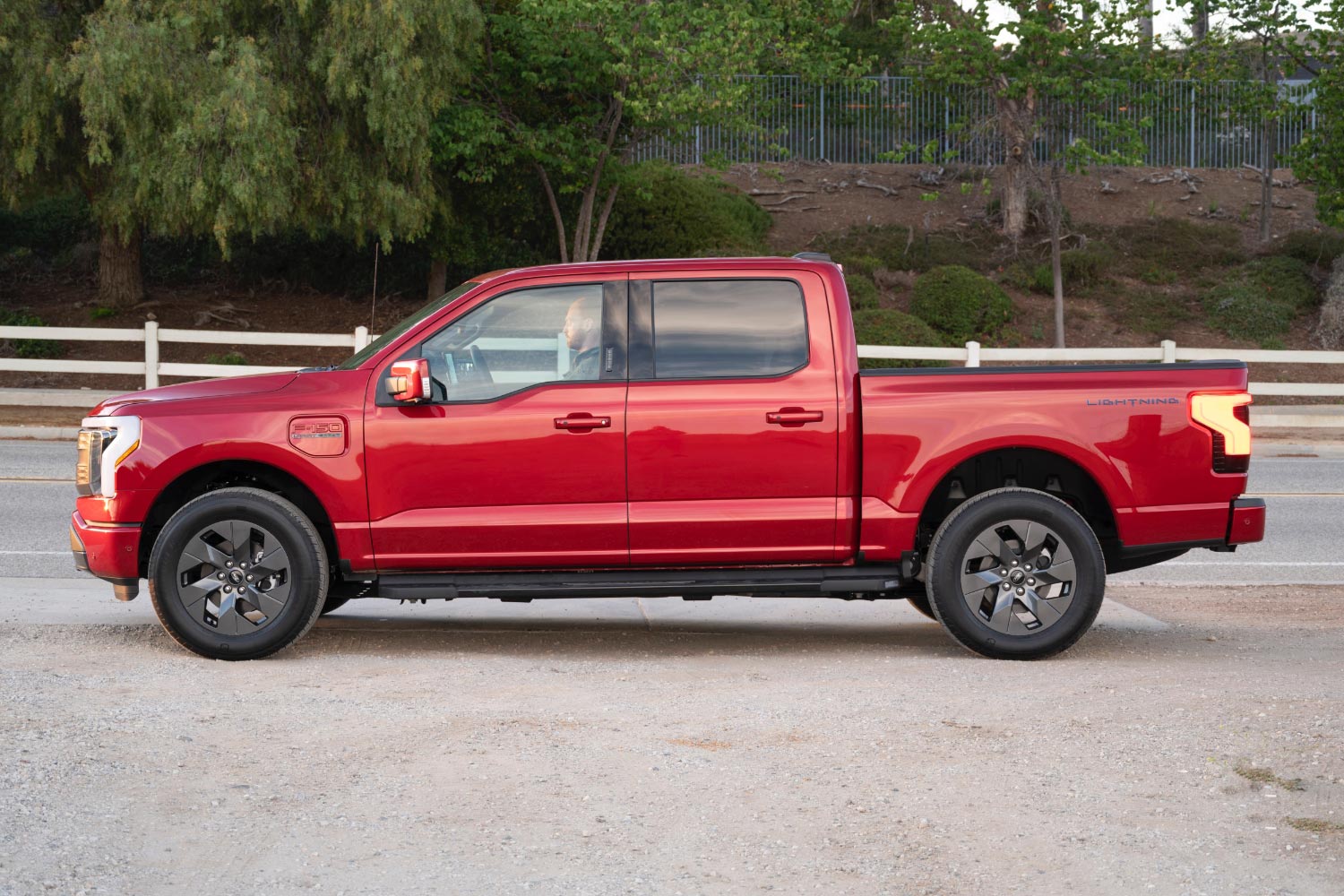 Michael Harley
Michael Harley
With its clean and aerodynamically focused styling the Lightning is clearly a Ford, but one with a different mission. Its front end is sleek and low to push air around the truck, as the ground clearance isn't a primary concern. The closed grille features a subtle Ford oval logo, and the hood goes unadorned. The running boards are small and tucked away, and there are no exhaust outlets because it's electric. However, the Lightning's most distinctive feature is its full-width white LED light bar on the nose, repeated with a full-width red LED light bar across the tailgate.
In contrast to the unique exteriors, the passenger compartments of the F-150 Raptor and F-150 Lightning Lariat are remarkably alike. Despite an abundance of plastics, materials are of better-than-average quality throughout the cabin, and Ford made a notable attempt to make everything project an upscale appearance and feel premium.
The Raptor and Lightning share a virtually identical dashboard layout and primary instrument cluster, although the information and graphics are unique to the model. The leather-wrapped steering wheel on the Raptor is slightly sportier. Still, many of the buttons, stalks, and controls are practically the same.
 Michael Harley
Michael Harley
That said, Ford has gone two completely different directions with the dashboard center stack layouts – and it's more than just the unique infotainment displays. The Raptor features a more traditional 12-inch touchscreen set in landscape orientation underscored by four physical dials to control the dual-climate system's temperature, stereo volume, and radio tuning. And there are physical buttons to adjust seat heating and cooling. In contrast, the futuristic F-150 Lightning boasts a sizeable 15.5-inch touchscreen set in portrait orientation, and it supports all climate control and stereo functions, allowing Ford to remove nearly all dials, knobs, and buttons.
In practice, the Raptor has a more intuitive and easier-to-use dashboard. The physical controls allow drivers to adjust the cabin temperature and stereo via muscle memory, keeping their eyes on the road. The Lightning's system is more robust and capable. Still, the flat-screen technology requires a glance to the center stack and then a strategically placed finger to initiate action, and that's distracting. The digital instrument cluster on the Lightning aligns well with its electric theme, but the digital display on the Raptor appears gimmicky. I would prefer a more traditional analog layout.
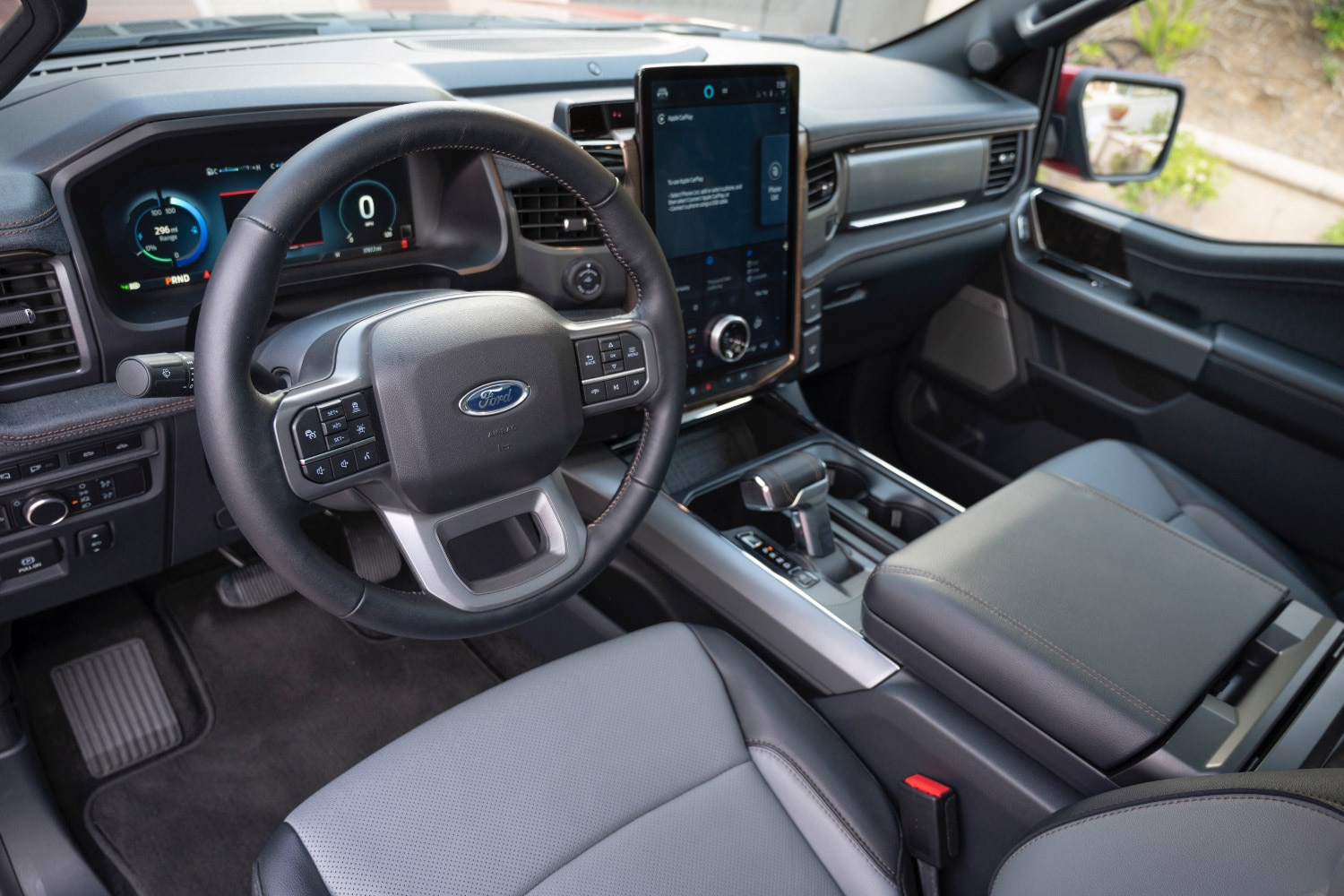 Michael Harley
Michael Harley
The F-150's passenger compartment is cavernous and comfortable, and most Americans of various statures will fit just fine. The driver will be pleased to learn that the pedals, steering wheel, and seat belt anchors also adjust to refine the seating position. Standard Raptor models have sporty seats with additional foam bolstering, but those with the 37 Performance Package are equipped with more supportive Recaro seats. The Recaros mix leather and suede on their seating surfaces, which makes them attractive and premium to the touch. The Lightning Lariat has similar 10-way power-adjustable seats but with much flatter cushions, and the perforated leather feels inelegantly like vinyl. In each model, the rear seats are nearly identical in shape with a minor variation in the stitching pattern.
 Michael Harley
Michael Harley
Occupants will find the F-150's cabin highly functional. The door pockets have generous storage space, two glove boxes on the passenger side dashboard, and a spacious center console. There's even a tiny tray behind the infotainment screen, which is ideal for holding a pair of glasses. Furthermore, there are power outlets galore and a wireless charging pad just in front of the shift lever that works perfectly (even for large phones). The only disappointment in the cabin is the size of the two console cupholders, which aren't able to accommodate a large, insulated tumbler.
In addition, I can't fail to mention each test truck's Interior Work Surface. Press a button, and the transmission shifter motors out of the way, allowing the hinged armrest to open to a spacious table. Naturally, you can only use it while parked, but it is nevertheless handy and a feature unavailable in the F-150's rivals.
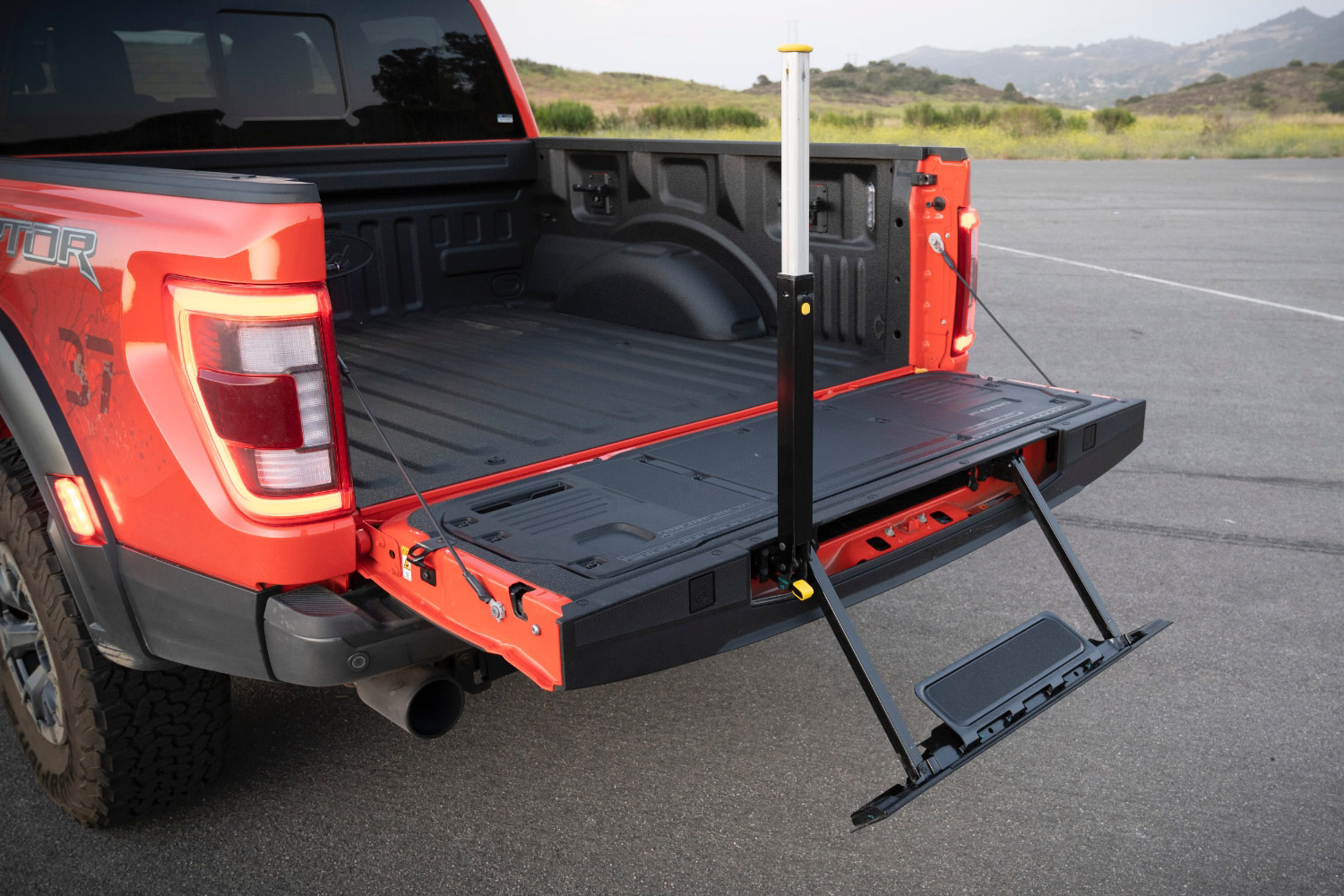 Michael Harley
Michael Harley
Pickups are renowned for their useful load beds, and Ford has nearly perfected the F-150's cargo area. Both test trucks had durable spray-in liner options, proper tie-down anchors, bed illumination, and an integrated Tailgate Step that helps people climb into the cargo area safely and with minimal effort. Kudos to Ford for utilizing the nose of the all-electric Lightning for its Mega Power Frunk. The power-operated, lockable, and waterproof storage area provides a handy 14 cubic feet of storage and can hold a whopping 400 pounds.
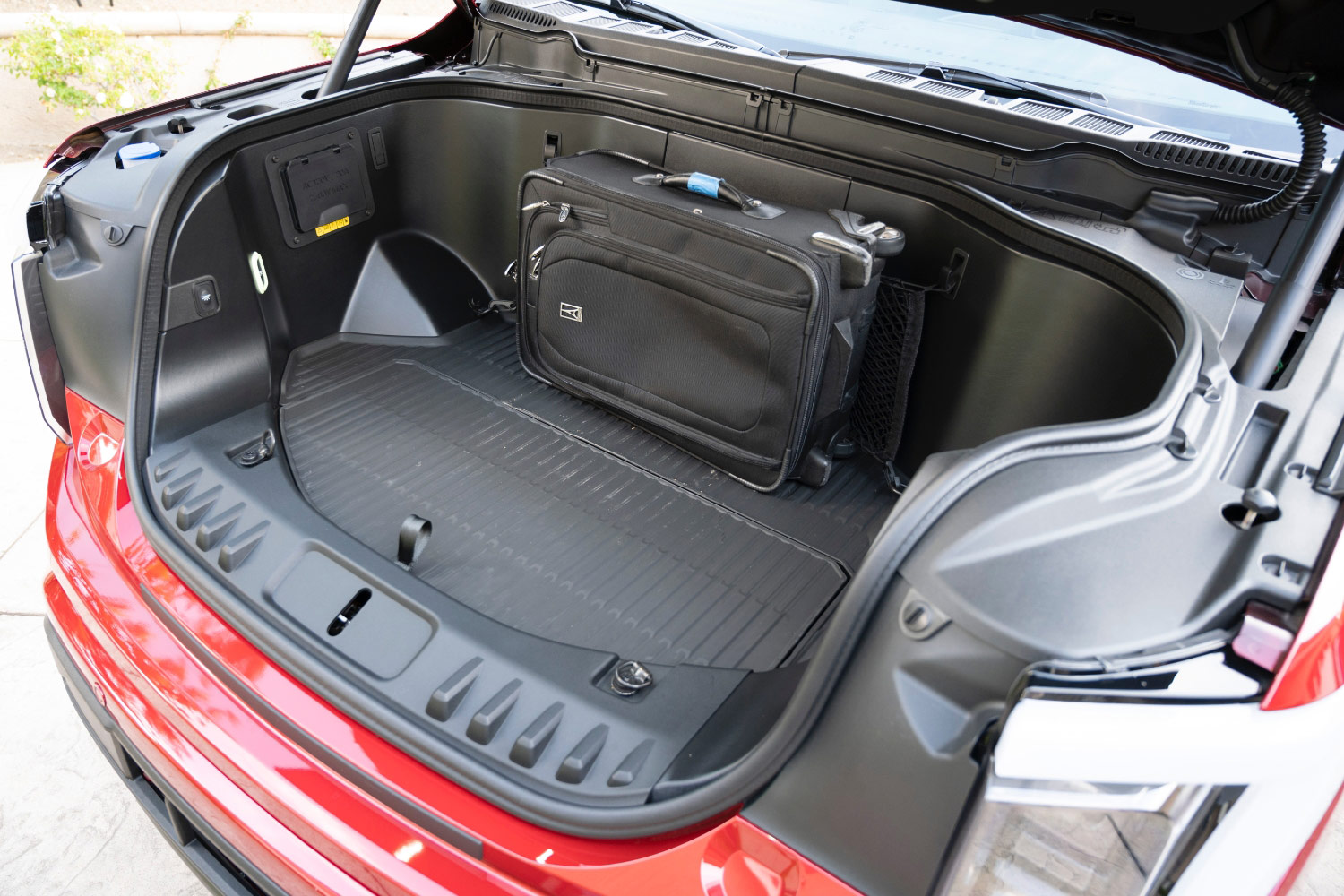 Michael Harley
Michael Harley
The Raptor came with the 2.0-kW Pro-Power Onboard system. It exports that amount of electrical power from the engine via 120-volt outlets mounted on the inner left wall of the bed. The Lightning offers a more robust 9.6-kWh onboard generator, and the EV exports power via 120-volt outlets in its Mega Power Frunk and 120- and 240-volt outlets in its cargo bed.
2022 Ford F-150 Review: The Technology
Pickup trucks used to be workhorses with minimalist interiors featuring metal dashboards, vinyl bench seats, and nothing more innovative than an analog AM/FM radio. All that has changed drastically, and for the better. The 2022 Ford F-150 is more technically advanced and innovative—by a wide margin—than any of the F-150s that came before it.
Ford offers the F-150 with a variety of instrument clusters and displays. Base models are heavy on analog gauges and small infotainment screens ranging from 4.2 inches to 8 inches in size. However, the test trucks came with a premium 12-inch digital Electric Vehicle Interface Controller (EVIC) display.
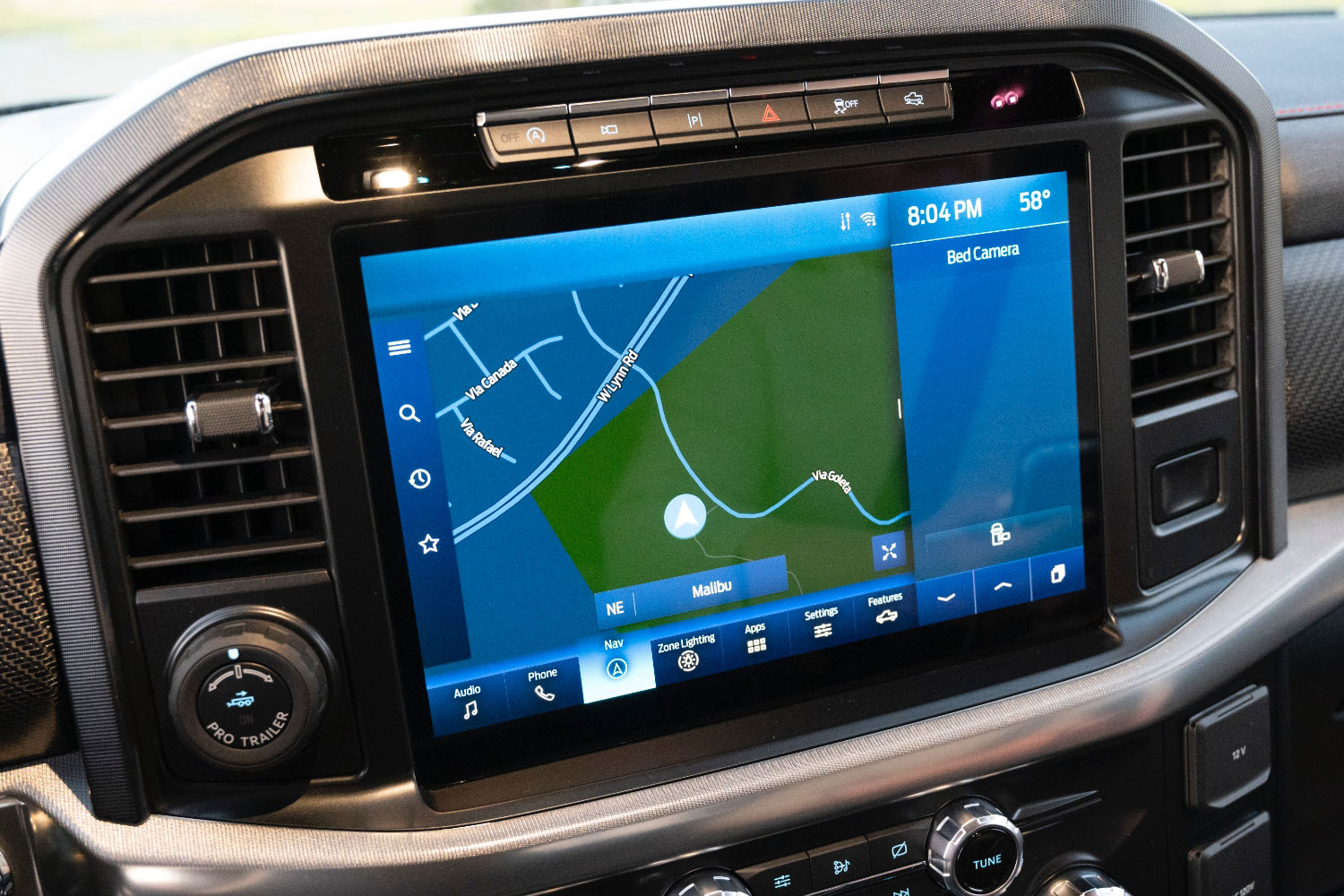 Michael Harley
Michael Harley
The combustion-powered Raptor projects the engine's speed (tachometer) and vehicle speed (speedometer) in bold characters on each display side, leaving the center area for other data and details, such as the trip computer. A small row of displays is also at the top for monitoring the Raptor's fluid temperatures and pressures. The electric Lightning projects discharging/regeneration and battery state-of-charge on the left side of the digital instrumentation panel and vehicle speed on the right. The center area is also reconfigurable for many of the same features found in the Raptor.
The Raptor's 12-inch infotainment screen runs on Ford's Sync 4 operating system that promises enhanced voice recognition, cloud-based connectivity including a Wi-Fi hotspot, Bluetooth, wireless Apple CarPlay and Android Auto, and Sync AppLink remote access via smartphone. It also offers customizable touchscreen options. In practice, it's intuitive and works well, but there are still too many menus to dive through. That's frustrating, especially to someone unfamiliar with the system.
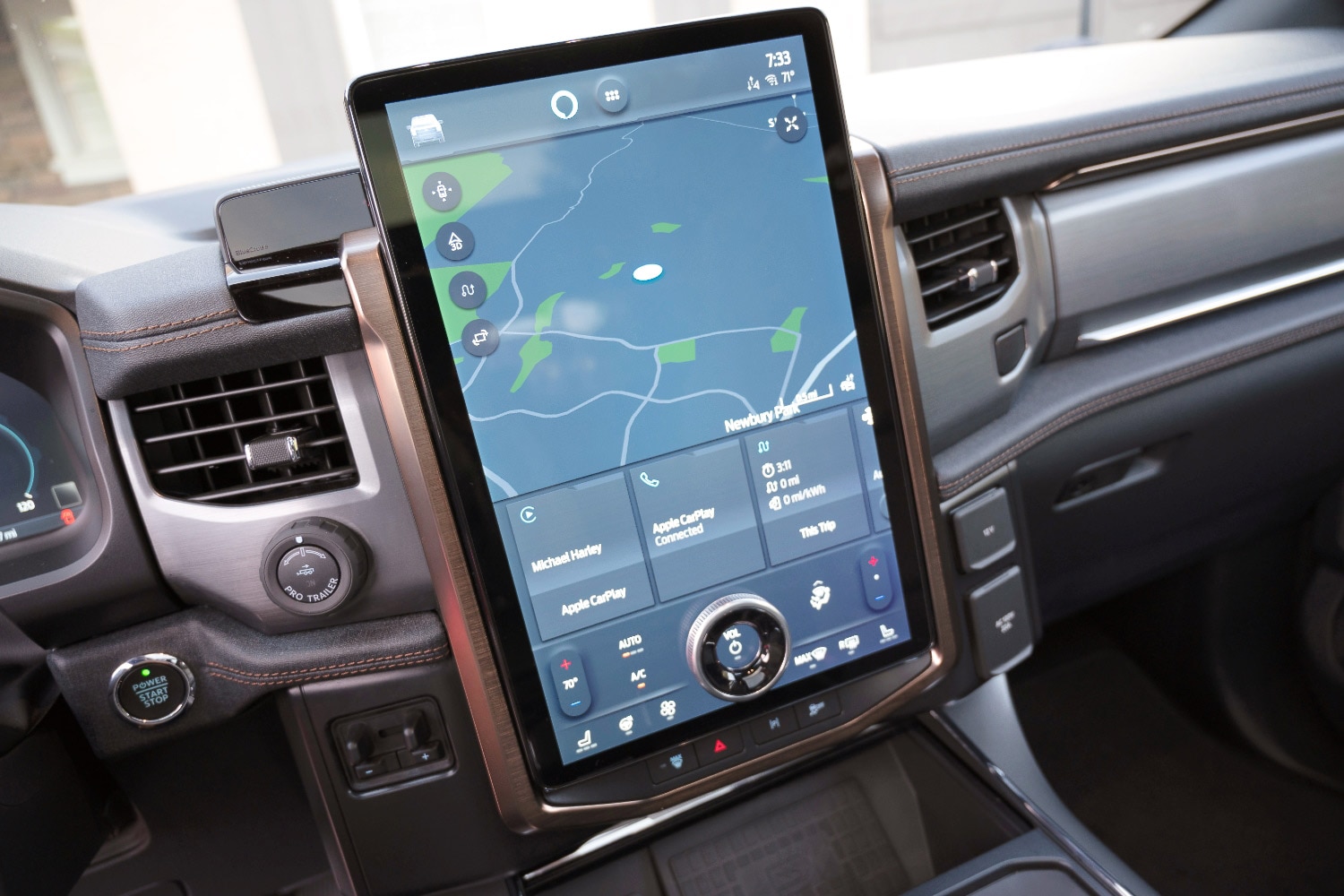 Michael Harley
Michael Harley
The Lightning's larger 15.5-inch touchscreen runs on Ford's Sync 4A technology, which builds upon Sync 4 by adding Adaptive Dash Cards. The cards show recently used or popular features that display horizontally underneath the central portion of the screen, thus eliminating the need to dig through menus. Sync 4A, with the cards, is countless times easier to use and much more user-friendly than Sync 4. Regrettably, Ford says you cannot upgrade Sync 4 to Sync 4A.
Truth be told, I used Apple CarPlay about 90 percent of the time in both trucks, in conjunction with the wireless charging pad). Both screens displayed the third-party graphics well, but my nod of approval goes to the larger, portrait-mounted screen in the Ford Lightning. The display is easier to read at a glance because it is slightly taller on the center console and more prominent. Better yet, Ford has indicated that the 2023 F-150 Lightning will get an Android-based infotainment system from Google that features more advanced map integration and a robust lineup of third-party apps.
Both tested F-150 models had numerous advanced driving assistance systems (ADAS). My particular Raptor had forward-collision warning, automatic emergency braking, lane-departure warning, lane-keeping assist, automatic high-beam headlights, and adaptive cruise control. The adaptive cruise works well – especially in stop-and-go traffic – and I used it at every opportunity. In addition, all Raptor models have Ford's Trail Control and Trail 1-Pedal Drive; think of them as adaptive cruise control for off-roading, increasing capability and safety.
The F-150 Lightning had these features plus Ford's advanced BlueCruise hands-free highway driver assist technology. It pairs adaptive cruise control with lane-centering technology, allowing for hands-free driving on 130,000 miles of "prequalified sections" of highways that Ford calls "Hands-Free Blue Zones." First, the driver sets the adaptive cruise control with the steering wheel controls. Then, if the vehicle's software recognizes the road as "approved," the instrument cluster illuminates with blue lighting to indicate you can drive the vehicle without your hands on the steering wheel. A discreet driver-facing camera monitors the operator's eyes to ensure they look forward at all times, ready to take control if necessary. Don't worry; it works with sunglasses.
In practice, BlueCruise requires a bit of trial and acclimation – it took me a day or two to trust it. However, it reduced my driver workload significantly when I was familiar with its operation and shortfalls. For example, the system is challenged in construction zones when lanes are not striped or are narrower than usual.
The Insurance Institute for Highway Safety (IIHS) has tested the 2022 Ford F-150 and named it a Top Safety Pick. In addition, the National Highway Traffic Safety Administration (NHTSA) gives the 2022 Ford F-150 an overall five-star rating. The ratings do not apply to the Lightning, which had not undergone testing as this review was written.
 Michael Harley
Michael Harley
2022 Ford F-150 Review: The Drive
Ford offers various internal combustion engine choices for its 2022 F-150, and the Raptor test truck had the most potent one. The Raptor's high-output, twin-turbocharged, 3.5L V6 develops 450 horsepower and 510 lb.-ft. of torque and mates to a 10-speed automatic transmission. The four-wheel-drive system includes a two-speed transfer case with low range, which provides extra-low gearing for climbing steep mountains, sludging through mud, and crawling over rocks. The Raptor also has a six-mode Terrain Management System (TMS) offering Normal, Grass/Gravel/Snow, Mud/Sand, Baja, and Rock driving modes.
 Michael Harley
Michael Harley
Even at idle, there's no mistaking the Raptor's performance mission because the turbocharged V6 boisterously growls while sitting still. Mash the throttle pedal, and the growl becomes a roar as the high-output engine comes to life. Despite a nearly 5,900-pound curb weight, the sprint to 60 mph takes a mere 5.5 seconds, which is faster than nearly all other trucks (and quicker than most cars).
The turbocharged V6 and 10-speed automatic make a great team, and turbo lag is almost non-existent. Around town, the powertrain downshifts quickly to put the engine in its power band where it can roar boastfully ahead. Although highway acceleration is not as vigorous, the taller gearing and aerodynamic drag work against the Raptor.
Unfortunately, the power comes at the cost of fuel economy. On my 48.4-mile evaluation loop, including mountain and highway driving, I averaged 16.3 mpg. Still, that's better than the official EPA fuel economy estimate of 15 mpg when the truck has the Raptor 37 Performance Package.
It's important to mention that Ford offers 35-inch tires as standard fitment. While they are a bit smaller in height – and somewhat less capable off-road – the wheel and tire combination is lighter. As a result, it will provide a slightly smoother ride, quicker acceleration, and better fuel economy than A Raptor riding on the optional 37-inch tires.
Dynamic handling is better than expected, but the knobby off-road tires, tall ride height, and abundant mass defeat sports car-like agility. Nevertheless, the Raptor does well in carving its way down a twisty canyon road and is quite fun to drive in this manner. The steering ratio isn't very quick, but it's easy to guide the truck through a corner without shuffling hands. Much credit goes to the standard Fox shock absorbers with adaptive electronic valving, which significantly improve the ride and keep excessive body roll in check. As expected, there was a bit of concern about bringing a nearly three-ton truck to a stop, but the Raptor's brakes are strong and effective, and they stop the truck quickly without drama.
My wife and I took the Raptor to a challenging off-road venue, and it performed faultlessly. With 13.1 inches of ground clearance and massive off-road tires, it bounded over ruts and rugged terrain effortlessly. It climbed hills like a Billy goat and crawled through deep sand as if the surface was paved. Yet, despite the punishing landscape, the ride was surprisingly comfortable.
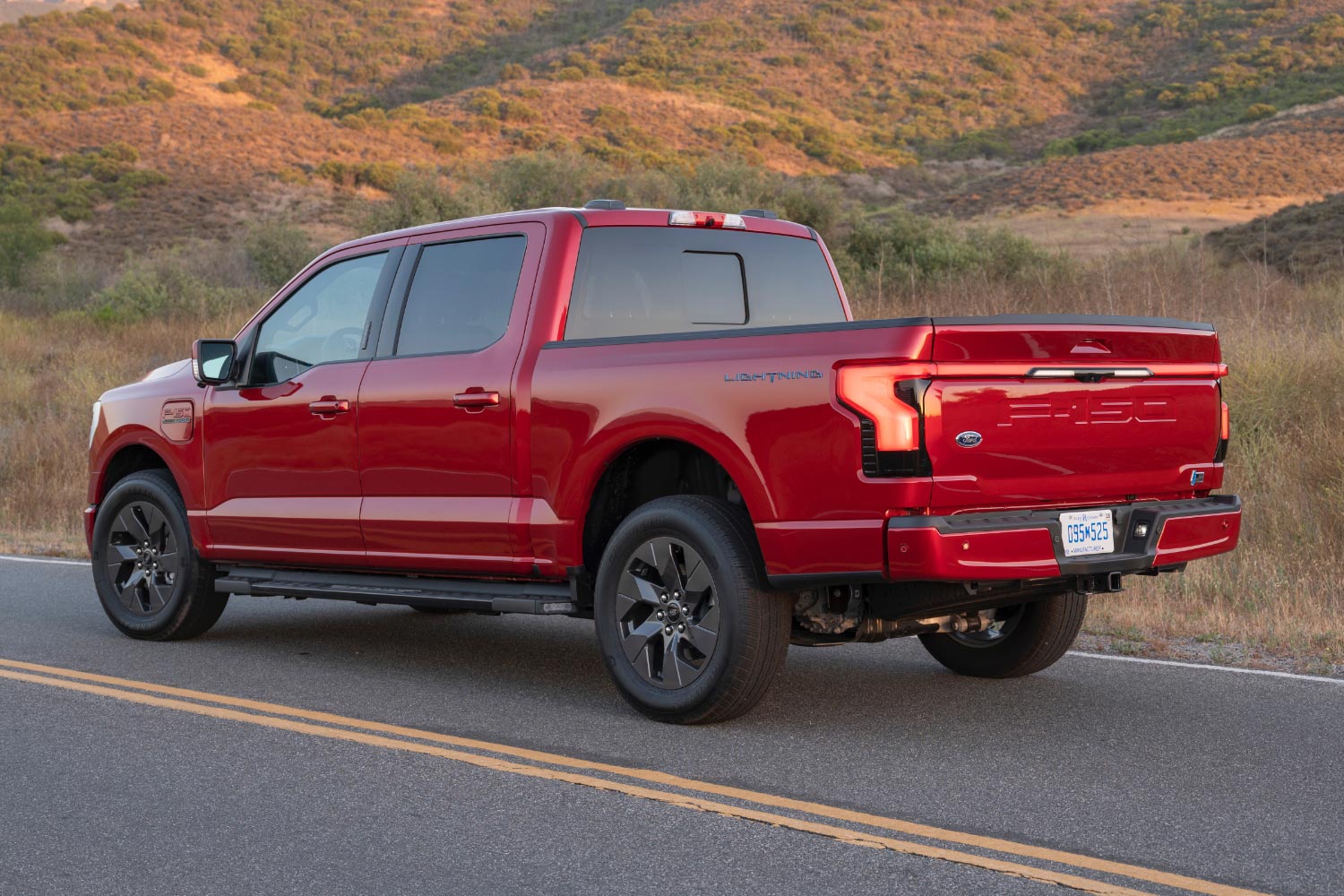 Michael Harley
Michael Harley
Open the hood of the Ford F-150 Lightning, and you'll find an empty Mega Power Frunk because the two motors are tucked out of sight beneath the truck, one for each axle to create an all-wheel-drive system. Ford rates the electric motors at a combined total of 563 hp and 775 lb.-ft. of torque. The Extended Range Lightning has a huge 131 kWh battery pack, which pushes the vehicle's curb weight to about 6,600 pounds. That's a lot of mass, yet the Lightning dismisses it effortlessly. Smash the accelerator to the floor, and the electric pickup claws to 60 mph from a standstill in just four seconds, making the Lightning the quickest F-150 model in today's lineup. Indeed, most modern sports cars are slower than the electrified Ford truck.
Instant torque from the twin electric motors provides colossal power levels with neck-snapping responsiveness at speeds below 50 mph. The immediacy and thrust diminish on the highway, where its single-speed transmission is less optimal. Yet, the Lightning is still quicker than the Raptor when measuring responsiveness and passing ability. Remember that electric motors are unaffected by temperature or altitude, unlike combustion vehicles that lose power in the mountains due to thinner air. Hence, the power output remains consistent regardless of where owners drive.
The two motors are identical except for slightly different reduction gearing and an e-locker function for the rear motor to improve off-road capability. Because the motors have equal power output, there is slight wheelspin from the front wheels as weight transfers rearward under hard acceleration. In contrast to the F-150 Raptor, which reserves the use of 4WD off-road operation, the F-150 Lightning drives like a large front-wheel-drive vehicle. (Other automakers, such as Porsche, use larger motors in the rear to maintain rear-biased driving dynamics.) The Lightning's heavy battery pack keeps the center of gravity low, so there is minimal body roll. Dynamically, it is quite the opposite of the Raptor.
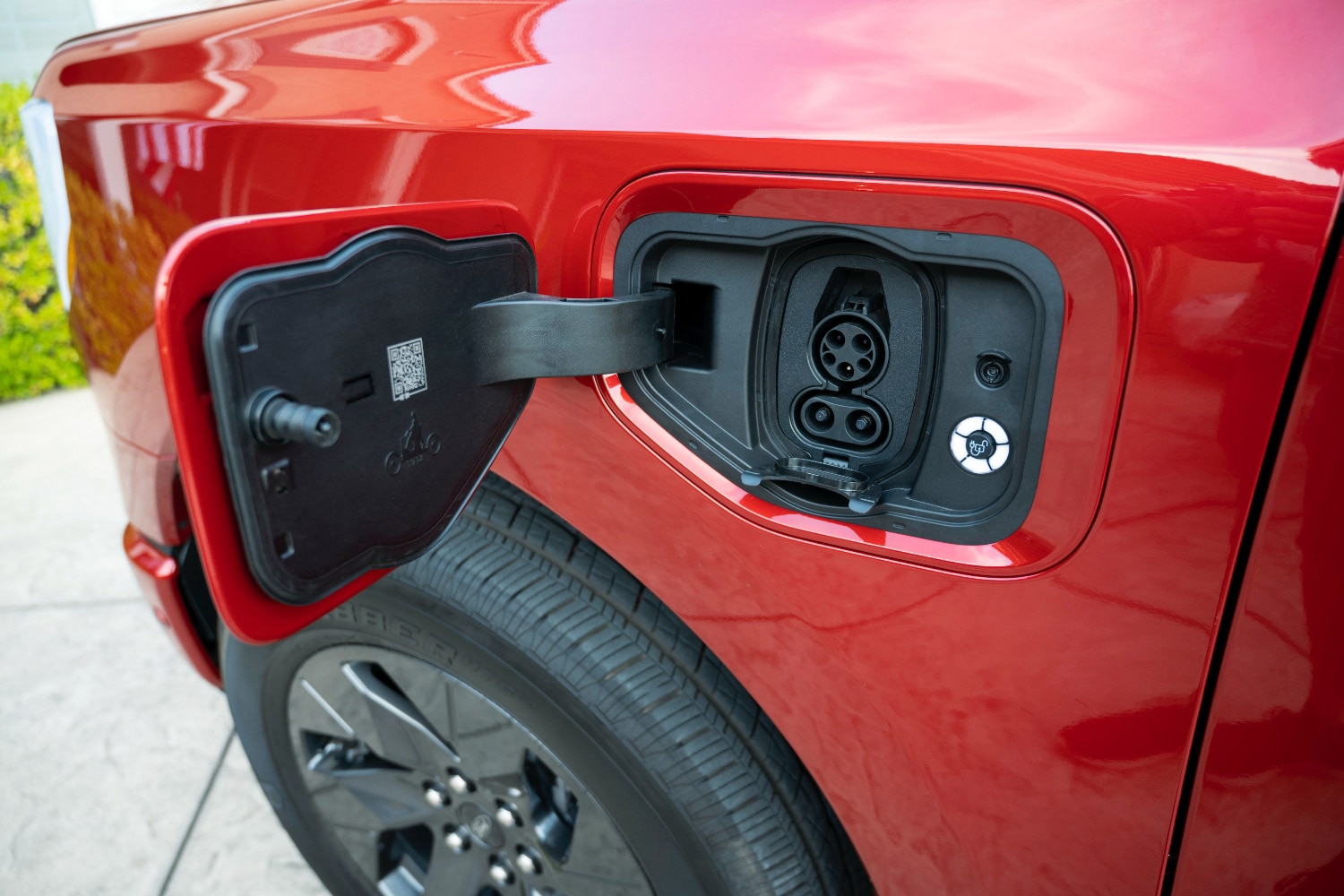 Michael Harley
Michael Harley
Ford provides four drive modes for the Lightning: Normal, Sport, Tow/Haul, and Off-Road. Plus, there are options in the driving menu for "one-pedal" driving, which allows you to accelerate and brake using only the accelerator pedal. I preferred Normal for all my driving, as Sport mode made the accelerator pedal a bit too touchy underfoot. I would like to have seen an Eco mode for those trying to maximize range, but Ford curiously left it out.
Around town, the Lightning gives the impression of being heavy and substantial. Yet, its robust acceleration means it never feels ponderous or massive from behind the wheel. All-season tires engineered to reduce rolling resistance and an independent rear suspension help provide a smooth ride, and the lack of an exhaust note adds to the serenity. The passenger cabin is tranquil, and conversation with other passengers is unproblematic.
I never towed or went off-road with the Lightning. Although the truck is capable of both, towing reduces range dramatically, and its 8.9 inches of ground clearance limits rock-climbing capability. I charged the Lightning nightly on a home 50A Level 2 charger. Each morning I would wake to an estimated 327 miles of range – my experience was that Ford was spot-on with its range estimates. During a day trip to Los Angeles, I drove 93 miles and used up 92 miles of range.
Is the 2022 Ford F-150 a Good Truck?
Ford offers the fourteenth-generation F-150 in so many trim levels and configurations that it checks off nearly every imaginable box in terms of utility, capability, passenger comfort, technology, safety, and innovation. From the rugged off-road Raptor to the combustion-free Lightning, there's an F-150 for every use case. The aluminum-bodied truck has proven to be a well-built vehicle with a substantial resale value that should provide decades of use even under the most severe operating conditions. It isn't hard to understand why it's been the world's best-selling vehicle for more than 40 years.
Ford F-150 Competitors for 2022
Ford last redesigned the F-150 for the 2021 model year, so it is fresh and ready to take on all comers in the full-size, light-duty pickup truck segment. They include the Chevrolet Silverado 1500, the GMC Sierra 1500, the Nissan Titan, the Ram 1500, and the completely redesigned 2022 Toyota Tundra. As for the new F-150 Lightning electric pickup, it will initially compete only with the Rivian R1T. However, electric versions of the Chevy Silverado and Ram 1500 are in the works, and the Tesla Cybertruck is also on the horizon.
Ford F-150 Features
Ford sells a highly diverse lineup of full-size pickup trucks, with numerous body styles and engine options from which to choose. Among light-duty models, whether you need a basic regular cab workhorse, a luxurious 5-passenger family truck with a roomy crew cab, a high-performance off-roader, or a pure electric pickup with up to 320 miles of estimated range, the 2022 Ford F-150 lineup delivers.
2022 Ford F-150 Safety Features
- Post Collision Braking – Standard feature that brings the truck to a stop as soon as possible after a collision and airbag deployment
- Blind Spot Information System – Available blind-spot warning system with trailer coverage*
- Intersection Assist – Available feature automatically brakes the truck when a left turn is unsafe*
- Evasive Steering Assist – Available feature adds stability when the driver takes sudden action to avoid an obstacle*
- BlueCruise – Available hands-free semi-autonomous driving assistance system approved for use on over 100,000 miles of North American roads*
2022 Ford F-150 Technology Features
- Sync 4 – Standard infotainment system with an available 12-inch touchscreen
- Sync 4A – Available infotainment system in F-150 Lightning with a 15.5-inch touchscreen*
- Trail Control with Trail 1-Pedal Drive – Available low-speed off-road cruise control with one-pedal driving capability*
- Active Park Assist 2.0 – Available feature that autonomously parks the truck while the driver remains in the driver's seat*
- Pro Power OnBoard – Available feature that transforms the truck into a generator and power source that can, in some cases, provide enough electricity to power a house*
2022 Ford F-150 Interior Features
- 18-speaker premium sound system – Available Bang & Olufsen audio system*
- Interior Work Surface – Available feature transforms the center console into a work surface*
- Heated and ventilated front seats – Available feature*
- Max Recline Seats – Available feature reclines the front seats nearly flat*
- Active Motion Seats – Available massaging front seats*
2022 Ford F-150 Specs
3.3L V6 engine
- 290 hp and 265 lb.-ft. of torque
- 10-speed automatic transmission
- Rear-wheel drive, four-wheel drive
- EPA fuel economy rating of 20 mpg to 21 mpg in combined driving
- 8,200-lb. maximum towing capacity (when properly equipped)
2.7L twin-turbocharged EcoBoost V6 engine
- 325 hp and 400 lb.-ft. of torque
- 10-speed automatic transmission
- Rear-wheel drive, four-wheel drive
- EPA fuel economy rating of 20 mpg to 22 mpg in combined driving
- 10,100-lb. maximum towing capacity (when properly equipped)
3.5L twin-turbocharged EcoBoost V6 engine
- 400 hp and 500 lb.-ft. of torque
- 10-speed automatic transmission
- Rear-wheel drive, four-wheel drive
- EPA fuel economy rating of 18 mpg to 20 mpg in combined driving
- 14,000-lb. maximum towing capacity (when properly equipped)
3.5L high-output twin-turbocharged EcoBoost V6 engine (Raptor only)
- 450 hp and 510 lb.-ft. of torque
- 10-speed automatic transmission
- Four-wheel drive
- EPA fuel economy rating of 15 mpg to 16 mpg in combined driving
- 8,200-lb. maximum towing capacity (when properly equipped)
3.5L twin-turbocharged EcoBoost V6 gas-electric hybrid engine
- 430 hp and 570 lb.-ft. of torque
- 10-speed automatic transmission with an integrated 33-kilowatt electric motor
- Rear-wheel drive, four-wheel drive
- EPA fuel economy rating of 23 mpg to 25 mpg in combined driving
- 12,700-lb. maximum towing capacity (when properly equipped)
5.0L V8 engine
- 400 hp and 410 lb.-ft. of torque
- 10-speed automatic transmission
- Rear-wheel drive, four-wheel drive
- EPA fuel economy rating of 18 mpg to 20 mpg in combined driving
- 13,000-lb. maximum towing capacity (when properly equipped)
Electric drive system (Lightning only)
- 563 hp and 775 lb.-ft. of torque (Ford estimate for extended-range battery)
- Front and rear electric motors create standard all-wheel drive
- Standard- or extended-range battery pack
- Driving range of 230 miles to 320 miles on a full charge (depending on configuration)
- 10,000-lb. maximum towing capacity (Ford estimate when properly equipped)
*Availability is subject to specific trim level selections



